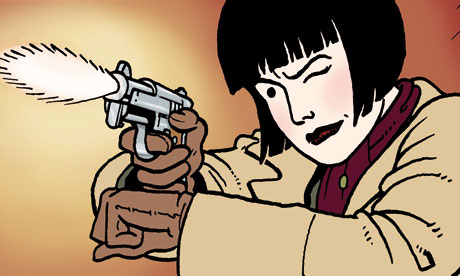
What to do when you have read – and read – all of the Tintin books? Well, why not try The Rainbow Orchid, the first Julius Chancer adventure?
The story comes in three volumes, the third and final of which has just been published, and I couldn't like it more if I tried. Its author, Garen Ewing, has listed among his inspirations both Hergé, and Edgar P Jacobs, the author of Blake and Mortimer (Jacobs is also a Belgian) and, like them, he uses ligne claire style to great effect, whether he's drawing the inside of the Natural History Museum or the mountains of the Hindu Kush. But this is a very British enterprise, too. Ewing's other influences clearly include the Lost World novels of Conan Doyle and Rider Haggard, and his pages are shot through with a wonderful Boy's Own nostalgia. Yes, he's in the business of derring-do. But what good is courage without stoicism, a certain diffidence and, above all, good manners?
The story so far. Lord Reginald Lawrence has entered into a foolish wager with the shady businessman, Urkaz Grope, over who will win an orchid competition. At stake is the Trembling Sword of Tybalt Stone, and with it the rights to the Lawrence estate, of which the family has been guardian since the 15th century. When the Daily News reporter, William Pickle, reveals that Grope has a secret weapon in the form of a supposedly black orchid, Lawrence hires Julius Chancer, young assistant to the historical researcher, Sir Alfred Catesby-Grey, to find the legendary rainbow orchid. Volume three picks the story up somewhere in the valleys of Chitral, where plucky Julius and Lawrence's charming daughter, the silent film star Lily Lawrence, plus her hapless agent, Nathaniel Crumpole, are still hard on the orchid's trail. Unfortunately, hard on their trail is Grope's "dark angel", the menacing Evelyn Crow, determined to stop them at any price.
I'd better not reveal, here, whether the rainbow orchid really exists, or what happens to the evil Grope in the end. But I will tell you that reading Julius Chancer in bed, late at night, is a great treat. It is all so beautifully done: the historical references are spot on (the books are set in the 1920s, and male characters will often refer to, say, their experiences in the Dardanelles), the dialogue is pitch perfect, and each book has immaculate end papers comprising a scrapbook of related newspaper stories, bill posters, war records, maps and photographs.
I love it that Ewing has put as much work into his minor characters – Newton the botanist, Benoit Tayaut the barnstormer, Mr Drubbin the government field agent – as into Julius, Lily and Sir Alfred. Combine this with his fiendish plot, and the result is one of the most satisfying comics around, whether you are a small boy, or a grown woman. Is there to be another Julius Chancer adventure? I hear that there is. Let us hope that the wait for it will not be too long.

